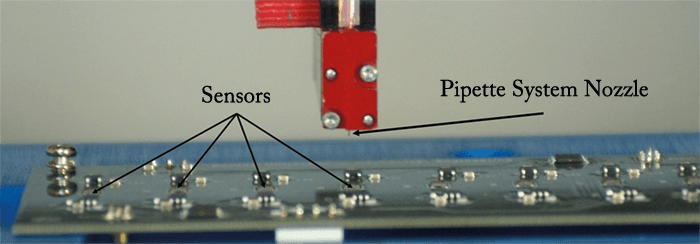What?
A “microelectromechanical resonator” – a small, vibrating sensor that may allow the sensitive, specific and affordable detection of biomarkers in even small volumes of blood (1). Senior author Jeffrey Rhoads explains…Why?
“What made us consider looking into biomarker detection? To be honest, George Chiu, Eric Nauman and I decided upon this research path over a water cooler conversation! George and I have worked together for nearly a decade on various sensing systems, primarily focusing on industrial and national security applications. Eric had been working on research problems related to traumatic brain injury, and he felt that our sensors might be able to have an impact in that space. The advantage of our method over other existing ones appears to stem from a combination of the high sensitivity of our devices, our statistics-based detection approach, and the fact that we require very small test volumes.”How?
“The system is based on resonant mass sensing. The basic idea is that you have a small-scale vibrating element – in this case, a small plate. The element has a series of frequencies at which it ‘likes’ to vibrate – natural frequencies, which depend on a number of design parameters, including the mass of the device. If you have a clever way to bind specific masses, like proteins, to your device – for instance, through a functional polymer layer – then you have a sensitive way to detect that biomarker. The challenge is to avoid false positives without using a large sample volume of test fluid. We circumvent this through the use of large sensor arrays, which leverage the power of statistics, and a sensor functionalization and material deposition technique based on small-scale bioprinting. Generally speaking, the sensing system is agnostic to what it detects. Functionality and selectivity are set solely by the functional layers that we deposit (and, if necessary, develop). For this work we deposited specific antibodies, embedded in a polymer, that have an affinity for the protein of interest. In our earlier work, we used similar techniques to detect analytes ranging from explosive vapors to volatile organic compounds.”
Who?
“Given the low-cost nature of our sensor, I think it might be well-suited for lab-based and perhaps even point-of-care diagnostics in the field. Our hope is to provide laboratory medicine professionals with an affordable sensing solution that takes less time to process than current gold-standard methods. Given that the required sample volumes are also low, we may also be able to help reduce the need for large volume fluid withdrawals – for example, enabling the use of finger sticks instead of full blood draws for some applications.”When?
“Before we can bring our biomarker detection sensor to the clinic, I suspect the next logical step is to conduct a small-scale clinical trial. We are currently looking for external partners who work in the clinical medicine space to aid with further testing. At the same time, we are working with the Purdue Research Foundation to identify potential technology transition partners. It’s our hope to be able to provide laboratories and field clinics with a better, cheaper biomarker sensor as soon as possible.”References
- MJ Wadas et al., “Detection of traumatic brain injury protein biomarkers with resonant microsystems”, IEEE Sensors Letters, 1, 2501304 (2017).




